An almost subliminal throbbing is often the first I hear of a Tengmalm’s Owl Aegolius funereus. It can carry up to 2 km or more. Dense growth and thigh-deep snow thwart many an attempt to get closer. I eventually found the male in CD1-29 on top of a small mountain in Sweden, but only after half an hour of hand and foot work. He promptly flew away. I felt like an idiot, sweating and panting as I stood with inappropriate shoes in the wet snow. So I tried hooting him back again. Fortunately, it worked.
CD1-29: Tengmalm’s Owl Aegolius funereus Bollnäs, Hälsingland, Sweden, 20:10, 24 March 2014. Hooting of a male, starting typically with a longer strophe or two. 140324. MR.201022.11
Not all owls hoot. Barn owls Tyto don’t. Their vocal anatomy forbids it (Miller 1934). Those that do belong to the Strigidae. All ‘hooting owls’ I can think of repeat their main territorial signal at regular intervals within a limited pitch range. In mature forests, songs with sustained pitches attract more attention. Owls hoot partly because this kind of sound works there so well.
In a dripping wet pine forest in northern Germany, a Tengmalm’s Owl resonates beautifully as echoes from trunks and branches blend together in the misty air (CD1-30). Tengmalm’s hooting varies dramatically from one individual to the next, most noticeably in the number of hoots in a series. This one averages just over 12, delivered at a rather fast pace. Another one, recorded on a windy night in a Swedish spruce forest, has around seven (CD1-31). There can be so much variation in a single forest that larger scale geographical differences only become clear after listening to many examples.
Boreal Owl A richardsoni of North America sounds identifiably different from Tengmalm’s Owl. Boreal generally delivers more hoots more quickly, reaching maximum pitch before the middle of the series, whereas Tengmalm’s delivers a smaller number of hoots more slowly in a series that usually rises more gradually in pitch. CD1-32 is a typical Boreal Owl. No single difference is fully diagnostic, but when all are combined, Boreal is a different sounding owl.
CD1-30: Tengmalm’s Owl Aegolius funereus Lüneburger Heide, Niedersachsen, Germany, 03:58, 30 April 2008. Hooting of a male. 080430.MR.035809.11
CD1-31: Tengmalm’s Owl Aegolius funereus Älgsjön, Värmland, Sweden, 21:39, 26 March 2014. Hooting of a male, perhaps hesitant because of recordist’s presence. Background: a strong gust of wind. 140326.MR.213944.01
CD1-32: Boreal Owl Aegolius richardsoni Alberta, Canada, 21:00, 2 March 1977. Hooting of a male. Background: Great Horned Owl Bubo virginianus. William W H Gunn & The Macaulay Library at the Cornell Lab of Ornithology
Tengmalm’s Owl and Boreal Owl are so similar in appearance and ecology that they have always been regarded as the same species. So I was surprised to learn that their mtDNA differs by a substantial 3.69% (Johnsen et al 2010). If we apply the standard mutation rate of roughly 2.1% change per million years (Weir & Schluter 2008), Tengmalm’s and Boreal went their separate ways around 1.8 million years ago. The Bering Strait has closed many times since then, but apparently Aegolius genes never crossed it again. We can only guess which continent is the ancestral home of Tengmalm’s and Boreal, but there are three more Aegolius owls in the Americas, and an extinct one used to live on Bermuda (Olson 2012).
Since Tengmalm’s Owl separated from Boreal Owl, its geographical range has been in a state of flux. During colder periods, Tengmalm’s occurred well to the south of where it breeds now. From east to west, remains have been found in southern Turkey, Crete, Italy and south-eastern Spain (Tyrberg 1998, 2008, Sánchez Marco 2004). In the west, it also reached Britain (Yalden & Albarella 2009). A different Aegolius species probably very similar to Tengmalm’s lived on densely forested Sicily in the Mid-Pleistocene. Like the extinct Sicilian Barn Owl, A martae grew larger than its presumed ancestor (Pavia 2008) and was roughly the size of a Hume’s Owl Strix butleri. In the Caucasus, Tengmalm’s subspecies A f caucasicus is another southern taxon thought to have become isolated during the Pleistocene. Individuals of caucasicus are smaller than those of other populations of Tengmalm’s.
My only encounter with a presumed caucasicus took place near Sivrikaya, a tiny village c 1800 m above sea level, set in a steep-sided valley in the Pontic Alps of north-eastern Turkey. Roy Slaterus and I left in the late afternoon, hoping to climb through the forests of Caucasian Spruce Picea orientalis and camp above the tree line some 300 m higher. At some ungodly hour in the morning we would climb another 350 m and place microphones in just the right spot, to capture sounds of the notoriously silent Caucasian Black Grouse Tetrao mlokosiewiczi. Or so we hoped.
Carrying a large transparent parabolic dish, a telescope and camping gear, we astonished one Turk that we met. He warned us about bears, and we scanned the slopes in vain hope of finding one, before it found us. When we could no longer see, we kept listening. It was Roy, sitting upright in our tent, who heard the Tengmalm’s Owl first. Lying down, I could hear nothing at all. Roy is razor sharp, so I had no doubt that he was right. Finally, when I sat up too, I could hear the owl faintly in the distance.
Despite being exhausted, we were determined to find it. At first while we descended into the dark spruces, the sound became louder. Then below a certain point it gradually became fainter again. Finally, we found ourselves at the lower edge of the forest, standing on the edge of a small stream. It could only be up beyond the next ridge, at least 200 m higher, and had become fainter when we descended below it. Defeated, we trudged back up to our tent.
We finally caught up with it four weeks later when we returned through the area in mid-June. Heading straight up the correct slope, we recorded it with little difficulty. Even this late in the spring, it was still singing like a mad thing, clearly an unpaired male (CD1-33). We know of no confirmed recordings of caucasicus, and one male is insufficient to judge whether it sounds any different from nominate funereus.
CD1-33: Tengmalm’s Owl Aegolius funereus Sivrikaya, Rize, Turkey, 13 June 2002. Hooting of an unpaired male. 02.035.MR.05020.01
Voles are subject to cycles of abundance over periods of three or four years. Growth of vegetation, seed crops, the duration and thickness of snow protection in winter, and the health of predator populations all influence the timing and severity of the fluctuations (Hansson & Henttonen 1985). The extremes are greatest in the far north, where peak vole numbers can be hundreds of times greater than the minimum level, over a vast area. In temperate Europe, vole cycles show roughly 10-fold fluctuations (Korpimäki & Hakkarainen 2012), and in southern Europe they are merely local.
Tengmalm’s Owls breed earlier and lay more eggs in times of plenty, when males may even mate with more than one female.
In famine years, such promiscuity is unthinkable, and males face a conflict of interests. Although they might find more voles elsewhere, a thorough knowledge of their territory helps them to find the last ones as well as a few birds. So if possible they stay and defend their territories and the all-important nest holes. Meanwhile, females and juveniles disperse widely in all directions, looking for the best supplies of food.
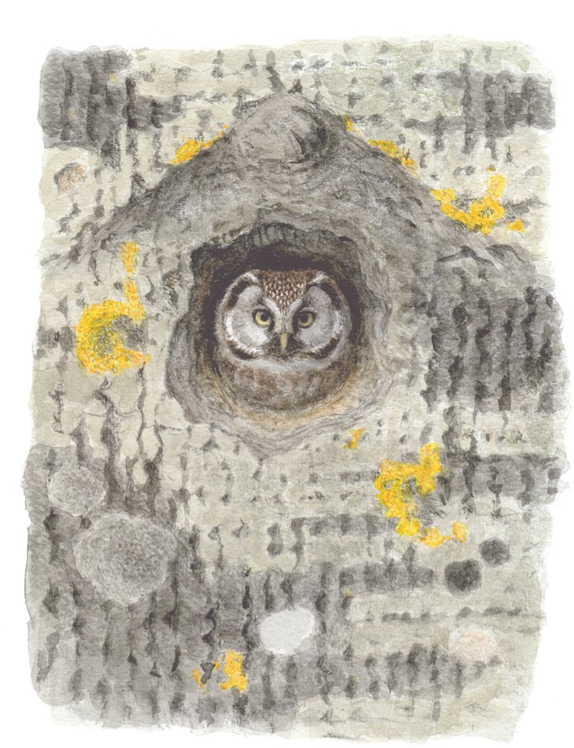
Håkan Delin
In Finland, females move an average of 20 times further than males between successive breeding attempts (Korpimäki & Hakkarainen 2012). Northern populations are the most volatile, adult males being nomadic there to a limited extent as well as females (Hipkiss et al 2002). In central Europe, the owls travel shorter distances, although movements over 100 km are not uncommon. Even the small, apparently isolated Pyrenean population is only viable because new birds frequently arrive from elsewhere. Tengmalm’s Owls from the Pyrenees, Fennoscandia and Far Eastern Siberia are very closely related (Koopman et al 2005, Broggi et al 2013). Given their mobility, birds from opposite ends of Eurasia could be maternal cousins just a few times removed.
In a vole year, male Tengmalm’s Owls start singing during the coldest part of the winter and gradually increase their efforts until early spring. Sometimes it may be weeks later when a male finally detects a female in his territory. An aggressive tsyuck is the first sign of her presence, as well as her initial hostility. This is a call that, as we will see, has many variants and uses. On hearing it, the male immediately changes strategy from long-distance advertisement to ‘warming up’ his potential mate with engagement hooting, usually from a perch close to a nest hole. The change is immediate, like flicking a switch (CD1-34). Engagement hooting is quieter than territorial hooting, with a stuttering rhythm (König 1968). It may last just a single evening or several, depending on the weather and how quickly the hostility thaws.
CD1-34: Tengmalm’s Owl Aegolius funereus Logbiermé, Liège, Belgium, 23:14, 9 April 2003. After three series of ‘normal’ hooting, a female’s tsyuck immediately elicits a change to engagement hooting in the male. 03.006.AB.10153.11
Next, the male progresses to his most excited form of hooting. He sits in the actual nest entrance and delivers an unbroken series of hoots, quieter and lower pitched than his usual hooting (CD1-35). This ‘location roll’ can last for several minutes without interruption. Almost inevitably, it results in the female flying to the nest hole. Imitating it may even cause flushed females to rush back to their nest. By the time location rolling starts, territorial hooting has usually ceased. Engagement song may in fact be a compromise between the two (Glutz von Blotzheim & Bauer 1980): a male may not want to commit himself to an ambivalent female, while he could still lure another one from afar.
CD1-35: Tengmalm’s Owl Aegolius funereus Schoonloo, Drenthe, Netherlands, 23:06, 8 May 2009. Location rolling of a male. 090508.PN.230600.03 Peter Nuyten
It is no wonder that females are fussy about who to mate with and which nest hole to accept. If the breeding attempt is to be successful, they will have to spend the best part of two months indoors. Most nests are in holes excavated by Black Woodpeckers Dryocopus martius. In fact, Tengmalm’s Owl breeds hardly anywhere in Europe lacking this woodpecker’s services. Sadly, mature forests with lots of holes are becoming rare. Nestboxes have become crucial for the maintenance of Tengmalm’s populations, and also make breeding possible in areas without Black Woodpeckers.
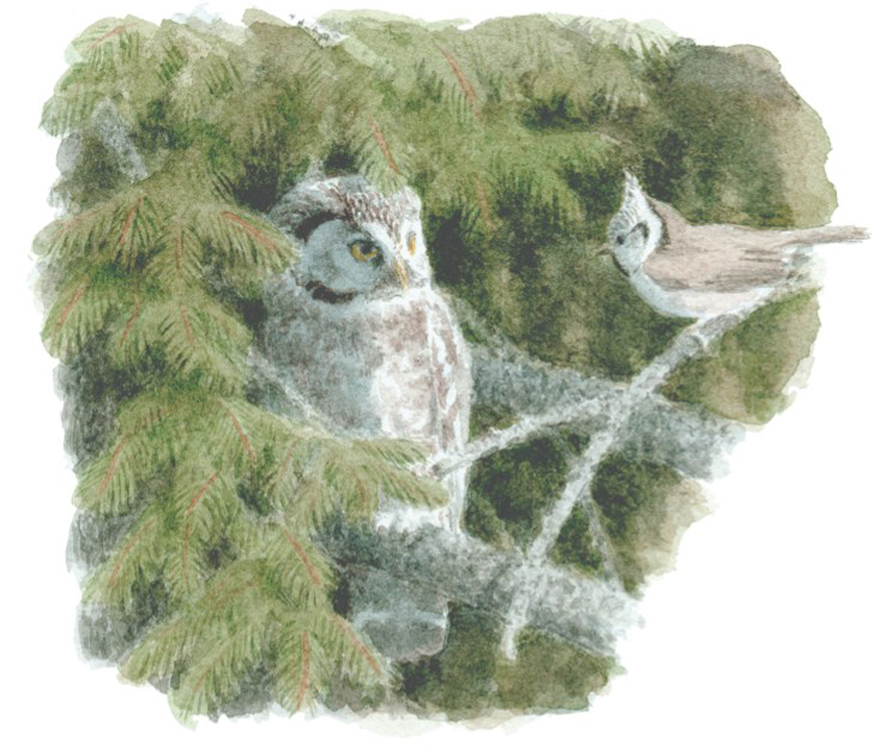
Håkan Delin
When the male comes to the nest, protocol must be followed. He, arriving with his hard-won prey, is wary of the larger female. She is wary of anything arriving at the nest hole that is not her mate.
She is particularly vulnerable to Pine Martens Martes martes and Beech Martens M foina. Scratch the bark at the bottom of her tree, and she will appear at the entrance immediately. Early in the breeding season, the male announces imminent arrival with ‘flight rolls’, a much shorter version of the location roll. After a while, these are replaced by unobtrusive contact calls, which have a rising, questioning intonation reminiscent of a little owl Athene. The female version is somewhat hoarser and higher-pitched than the male version (König 1968). She only uses it after her antagonism towards the male has melted away, towards the end of courtship.
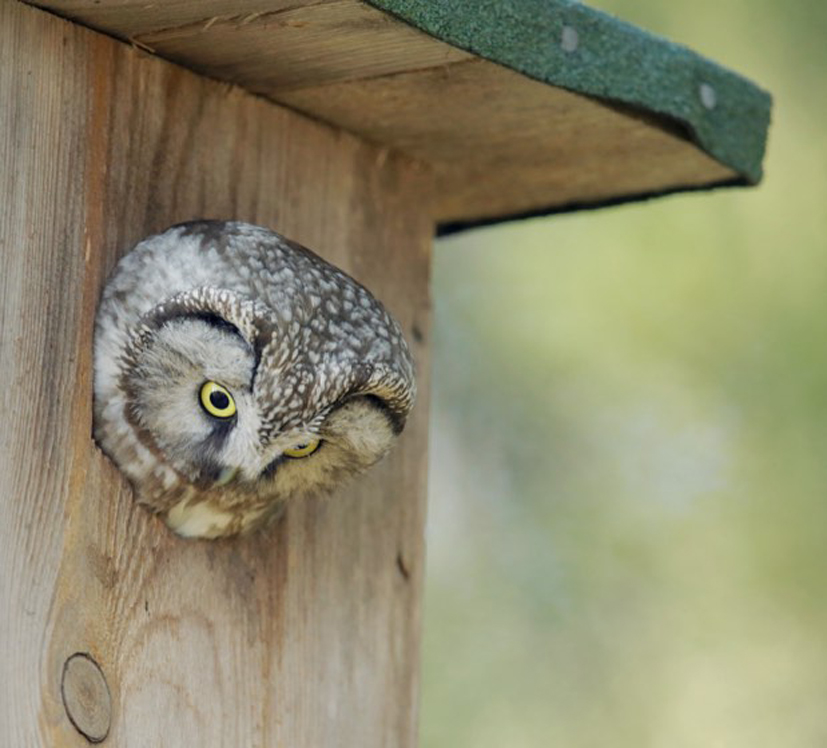
Tengmalm’s Owl Aegolius funereus, female, Kuusamo, Pohjois-Pohjanmaa, Finland, 22 May 2014 (Dick Forsman)
On hearing the male arrive, the female very often responds with her soliciting call, a short, extremely high-pitched sound, in the range of a Hazel Grouse Tetrastes bonasia or a Goldcrest Regulus regulus (CD1-36). Other names for it include ‘peeping call’ (Bondrup-Nielsen 1984) and ‘nest call’ (König 1968). Female Tengmalm’s Owls do not use their soliciting call as often as most other owl species.
CD1-36: Tengmalm’s Owl Aegolius funereus Lapua, Ostrobothnia, Finland, 01:16, 16 May 2009. Peeping calls of first-summer female, when male arrives at the nestbox with food. Before each peeping call, she gives a low, rising contact call. Background: chittering calls of several four-week-old young, Black Grouse Tetrao tetrix and Northern Lapwing Vanellus vanellus. 090516.MC.011600.01
When the young are still very small, the female tears up their food and gives them tiny pieces while uttering a feeding call (CD1-37). In rhythm and context this call is similar to the flight roll of the male. Despite being higher-pitched and hoarser, it may have prompted at least some reports of ‘female song’.
CD1-37: Tengmalm’s Owl Aegolius funereus Lapua, Ostrobothnia, Finland, 00:49, 16 May 2009. Feeding calls of female, with chittering of several four-week-old young. Background: Black Grouse Tetrao tetrix, Northern Lapwing Vanellus vanellus and Eurasian Woodcock Scolopax rusticola. 090516.MC.004920.12
A month or slightly more after hatching, the young are ready to leave the nest. They make their first flight from the nest itself, skipping the branch-hopping stage typical of many other forest owls. The three young begging in CD1-38 are ready for the big adventure. After they are all out, the male will gradually lead them towards good hunting areas. Their begging calls have to be loud enough for him to keep track of them, but without attracting unwelcome attention. Three quarters of juveniles never complete their first year (Schwerdtfeger 1991). Northern Goshawks Accipiter gentilis kill many, but Ural Owl Strix uralensis is probably their worst enemy. Håkan once had a memorable experience in central Sweden that taught him how dangerous Ural Owl can be.
CD1-38: Tengmalm’s Owl Aegolius funereus Lapua, Ostrobothnia, Finland, 22:13, 16 May 2009. Begging calls of three nearly fledged young. Background: Redwing Turdus iliacus. 090516.MC.221300.12
It was 13 May 1984, a calm evening with clear sky. As the light faded, Håkan was standing on a dirt track in swampy forest. First he whistled a Eurasian Pygmy Owl Glaucidium passerinum song, and a male came to perch in the top of a spruce. Then he whistled Tengmalm’s Owl. There was no answer, but a Ural Owl came gliding directly towards him and landed in a tree quite close behind. After a couple of minutes it flew back into the forest, the Pygmy mobbing it as it went. Håkan whistled Tengmalm’s again. The Ural came silently, stayed a while then disappeared, exactly the same as before. Håkan hooted and the Ural answered; it was a male. For a while they hooted to each other, but the Ural stayed where it was. After a new Tengmalm’s imitation, the optimistic Ural came again immediately but left empty-handed. The whole procedure was repeated a fourth time.
Shortly afterwards there was a sharp tsyuck quite close by: a real Tengmalm´s Owl had arrived. Håkan whistled some ‘song’ again, and moments later the Tengmalm´s was performing a war dance just a metre and a half in front of him: flying left and right at full speed with the sharpest possible turns. When it perched in a thin alder on the other side of the track, facing him, he saw its silhouette clearly against the sky, showing the oversized, heart-shaped head. With a Ural Owl just 50 m away, the situation was very tense; 10 seconds later he saw the Ural gliding towards the Tengmalm´s – approaching it from behind. Suddenly there was a wild chase over the forest track: the Tengmalm´s Owl with the Ural Owl just one metre behind.
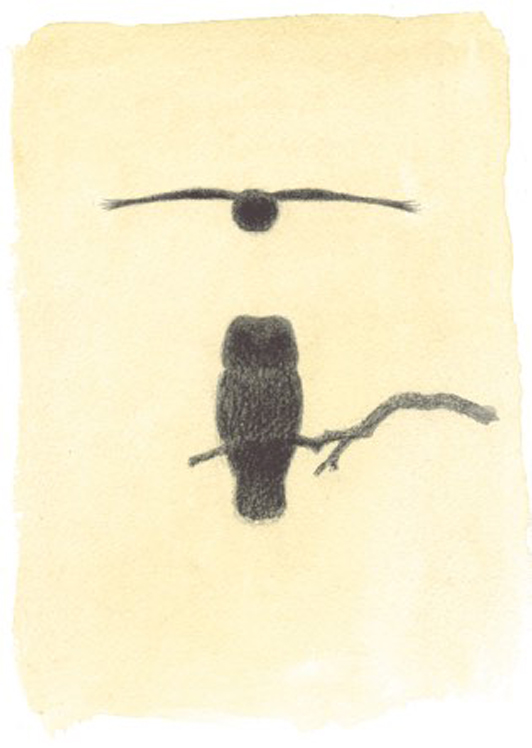
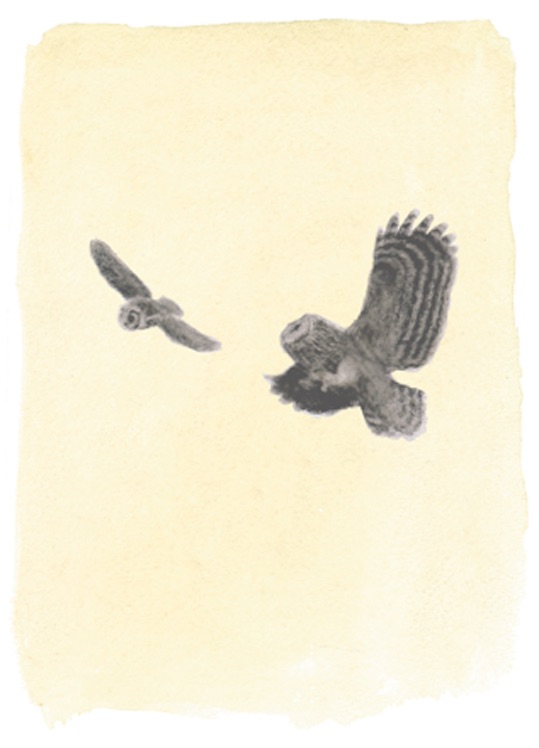
Håkan Delin
Håkan whistled again a couple of minutes later to learn the Tengmalm’s Owl’s fate. The Ural Owl came directly, for a fifth time. So the Tengmalm´s had survived after all. The Pygmy Owl, who was still around, dived aggressively towards the Ural’s head, and the big owl flew back into the forest. With a po-po-po-po-po-po… po-po-po-po-po-po… it answered a final challenge from Håkan. Then silence.
Surviving juveniles disperse from late summer onwards. Their movements peak in September in the far north and October further south, coinciding with those of adult females. When the vole population crashes, Tengmalm’s Owls can move on a massive scale. Matti Suopajärvi from the Kemi region at the north end of the Gulf of Bothnia has heard five to eight simultaneously. He sometimes hears them approaching from far off. When one tsyucks, any others within 400 m or so are very likely to answer.
In CD1-39, a Tengmalm’s Owl is on the move in Białowieża forest, Poland. It calls at long intervals, arriving from far to the left and passing to the right by 1:46. No imitation or tape lure was required: this was spontaneous behaviour. At longer distances, the tsyuck call appears to change from a ‘vertical’, short and broad-frequency sound to a ‘horizontal’ one, long lasting and limited to a narrow frequency range. Only the lowest frequencies travel far, and they leave a ‘sound tail’ in the resonant forest. For a Tengmalm’s, it must be fairly easy to judge the distance.
CD1-39: Tengmalm’s Owl Aegolius funereus Białowieża forest, Podłaskie, Poland, 03:35, 9 October 2012. Tsyuck calls passing slowly, at long intervals. Background: Song Thrush Turdus philomelos and Yellow-necked Mouse Apodemus flavicollis. 121009.MR.033538.00
Since they clearly like to stay in vocal contact, the intriguing possibility exists that Tengmalm’s Owls wander in loose flocks or ‘boids’. There is no proof, but occasional parallel movements seem to suggest this. In Sweden, two females that bred as neighbours 1 km apart in 1981 moved 70 km and bred 2 km apart in 1982 (Löfgren et al 1986). All three male Tengmalm’s discovered in the Netherlands in 2010 changed territory during that spring. Two that had been neighbours moved a few kilometres and defended adjoining territories at a second site (Ottens & Jonker 2010).
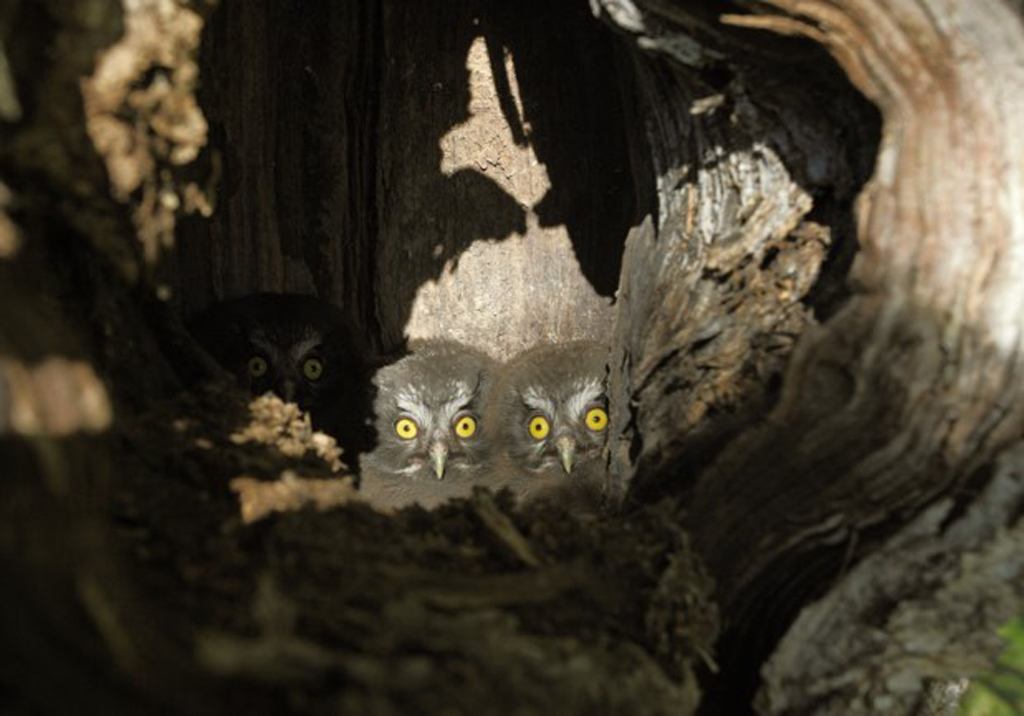
Tengmalm’s Owl Aegolius funereus, nestlings, Hauho, Kanta-Häme, Finland, 24 May 2009 (Dick Forsman). Young of c four weeks old, about to fledge within days. It is very rare to find a nest in a natural cavity as the species practically always uses a Black Woodpecker Dryocopus martius nest or a nestbox.
been planted and where the ecosystem is closer to natural equilibrium than anywhere else in lowland Europe. A year before my visit, several species of trees had been very generous. A glut of acorns and other seeds had given the forest rodents plenty to eat. Yellow-necked Mice Apodemus flavicollis and Bank Voles Myodes glareolus bred profusely in response, and so did the owls. They had their best breeding season in living memory. Now another bumper crop of acorns was falling from the trees, making for crunchy night walks along the forest tracks. I could hear rodents quite often, both by their squeaks and squabbles and by the rustle of litter on the forest floor.
When I imitated a Tengmalm’s Owl with my voice, the forest’s resonance gave me compliments I didn’t deserve. The tsyuck calls that often followed could be surprisingly loud (CD1- 40). Occasionally they could be longer, plaintive, descending squeaks (CD1-41). Defence, challenge and contact variants of the tsyuck call probably differ in ways that we have yet to decipher. In autumn it is almost impossible to know whether we are listening to a male defending his territory or a young bird looking for one. Both seem to use tsyuck calls.
CD1-40: Tengmalm’s Owl Aegolius funereus Białowieża forest, Podłaskie, Poland, 21:08, 4 October 2012. A single tsyuck call at close range. 121004.MR.210806.00
CD1-40: Tengmalm’s Owl Aegolius funereus Białowieża forest, Podłaskie, Poland, 22:33, 4 October 2012. A series of rather drawn-out tsyuck calls at close range. 121004. MR.223330.00
Male Tengmalm’s Owls sometimes respond to intrusions, whether real or simulated, with a stretched-out kyuweck, which can sound surprisingly similar to a Tawny Owl S aluco. CD1-42 illustrates this call at a lower level of intensity. With growing excitement, the ending becomes louder and rougher.
CD1-42: Tengmalm’s Owl Aegolius funereus Mäntyharju, Savonia, Finland, 23 February 2009. Kyuweck calls of an adult. Background: Northern Hawk-Owl Surnia ulula and Long-eared Owl Asio otus. Hannu Jännes.
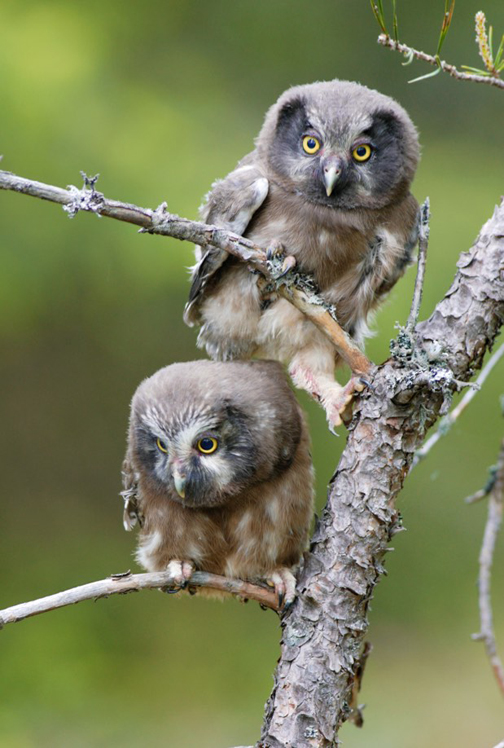
Tengmalm’s Owl Aegolius funereus, fledglings, Evo, Kanta-Häme, Finland, 1 June 2008 (Dick Forsman)
When planning an autumn trip for Tengmalm’s Owls, the sound I hoped to capture was ‘autumn song’, which can occasionally be heard “on windless, clear and usually quite cold evenings and nights, as September turns to October” (Kuhk 1953). When I arrived on 2 October 2012 the weather seemed perfect, so I took a long night walk through mature spruce forest. After nearly six hours without hearing any ‘song’, I assumed it was safe to go and sleep for a few hours. I left my equipment recording in a clearing where rodents were foraging under a patch of young European Hornbeams Carpinus betulus.
Only 20 minutes after I left, a Tengmalm’s Owl started singing so far away that, even when amplified, I could only just hear it. Melting into the primeval forest, the five individual hoots of each series were a faint throbbing hum on a single pitch, once every few seconds. The sharp metallic ticks of Song Thrushes Turdus philomelos migrating overhead could hardly have contrasted more. I walked many more kilometres over the following nights, but I never heard him again.
